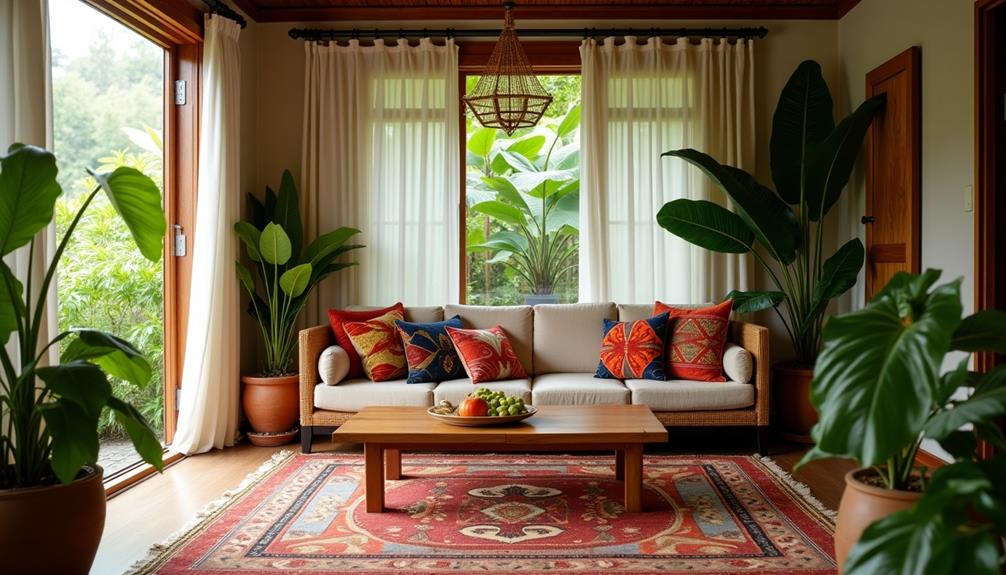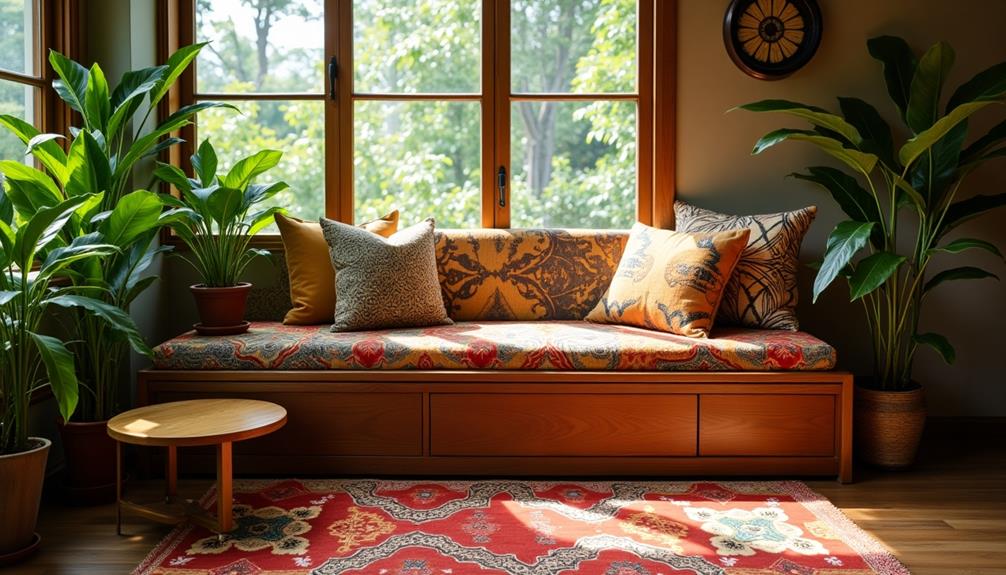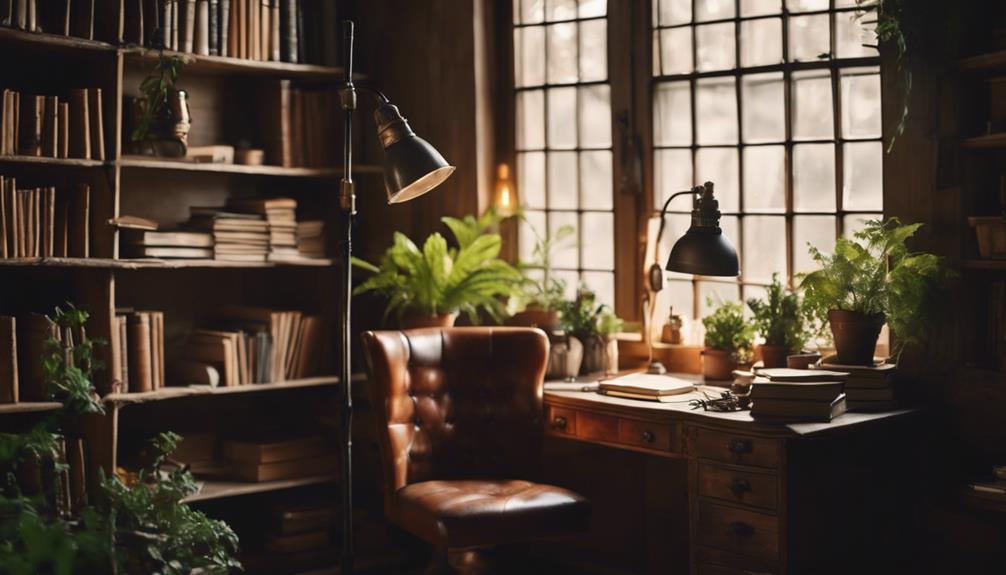You can transform your small space into a serene Indonesian-inspired oasis by embracing natural materials like teak and rattan, which add warmth and elegance. Choose a calming color palette of earthy tones and neutrals to create a tranquil atmosphere. Incorporate indoor plants to bring in vibrant greenery and use lightweight textiles for curtains and cushions to maintain an airy feel. Layer textures for comfort and optimize your lighting with soft, warm bulbs for ambiance. Finally, select multi-functional furniture, like a sofa bed or nesting tables, to maximize your space. Discover even more creative ideas to enhance your decor further!
Key Takeaways
- Embrace natural materials like teak and rattan to create an elegant yet cozy atmosphere in small spaces.
- Choose a calming color palette with earthy tones and neutral shades to enhance tranquility and perception of space.
- Incorporate indoor plants for vibrant decor and to improve air quality while adding texture and interest.
- Layer lightweight textiles, such as linen and cotton, to maintain an airy feel while providing comfort and visual depth.
- Select multi-functional furniture, like sofa beds and nesting tables, to maximize space without sacrificing style or functionality.
Embrace Natural Materials

When decorating small spaces, you should embrace natural materials to create an inviting atmosphere that feels both warm and spacious.
Start by incorporating wooden furniture crafted from durable options like teak. Teak's natural beauty and moisture resilience make it perfect for enhancing your decor while ensuring longevity. It'll add a touch of elegance and warmth to your space, especially when paired with Indonesian decorative pillows that feature vibrant colors and intricate patterns.
Don't overlook rattan, either. This traditional material blends seamlessly into both indoor and outdoor settings, making it ideal for small areas. Rattan furniture can help create a cohesive look without overwhelming your space.
You can also explore sustainable materials like bamboo. Known for its strength and flexibility, bamboo furniture provides an eco-friendly alternative that's stylish and functional.
To add texture and cultural depth, consider decorative elements made from clay and stone. These materials reflect Indonesia's rich heritage and infuse your space with rustic charm.
Lastly, layer natural fibers in textiles like cotton and linen. These lightweight materials not only create a cozy vibe but also keep your decor feeling airy, which is essential in smaller spaces.
Choose a Calming Color Palette

Choosing a calming color palette can transform your small space into a serene retreat. Opt for earthy tones like browns, greens, and beiges that mirror Indonesia's natural landscapes. These colors contribute to a tranquil atmosphere, perfect for compact living, and are reflective of the Balinese design characteristics that promote a connection to nature.
To enhance this effect, use neutral shades such as white, cream, and light grey as a backdrop. These hues create a soothing environment and help enlarge the perception of your space.
You can add a touch of personality with vibrant accent colors like terracotta or soft blues, but keep it minimal to avoid overwhelming your room. This balance is essential for maintaining harmony in your decor.
Layer textures by incorporating textiles in your chosen color scheme; cushions and throws in these calming shades can add depth and comfort.
Incorporate Indoor Plants

Bringing the lush beauty of Indonesia indoors can be as simple as incorporating tropical plants into your small space. Indoor plants like monstera and palm enhance your home decor while infusing a vibrant, tropical feel. Position larger plants as focal points to draw the eye, while using smaller varieties on surfaces to maximize space and maintain interest.
A great way to create impactful displays is by clustering plants in groups, mixing flowering and foliage varieties for seasonal diversity and added texture. You can also utilize hanging planters to save floor space, adding vertical interest that's perfect for compact areas. Choose low-maintenance plants for easy care, ensuring you can enjoy nature indoors without overwhelming your busy schedule.
Here's a quick guide to help you choose the right indoor plants:
| Plant Type | Care Level | Aesthetic Appeal |
|---|---|---|
| Monstera | Low | Bold, tropical |
| Snake Plant | Very Low | Sleek, modern |
| Pothos | Low | Lush, cascading |
| ZZ Plant | Very Low | Unique, sculptural |
Incorporating these plants will elevate your home decor while embracing an Indonesian-inspired vibe.
Utilize Lightweight Textiles

To create a breezy and inviting atmosphere in your small space, embrace lightweight textiles like linen and cotton for curtains and cushions.
Incorporating traditional artistry through vibrant Indonesian patterns can further enrich the aesthetic.
Layering these natural fabrics adds texture while keeping the look light and visually appealing.
Embrace Natural Fabrics
Incorporating lightweight textiles into your small space decor can transform your home into a serene retreat inspired by Indonesian design. Opt for natural materials like cotton and linen; they're breathable and enhance comfort while promoting a relaxed atmosphere. This choice is perfect for creating a home interior that feels open and inviting.
Additionally, consider incorporating elements like an Indonesian decor mask, which represents rich cultural heritage and can complement your textile choices beautifully.
To further embrace this Indonesian aesthetic, consider using natural fiber curtains. They allow plenty of sunlight to flood your space while maintaining privacy, resulting in a bright and airy ambiance.
You can also introduce vibrant batik or ikat patterned cushions and throws made from lightweight fabrics. These add color and texture without overwhelming your compact space.
Don't forget about the ground; handwoven mats or rugs made from sustainable materials like jute or seagrass can add warmth and a touch of nature to your decor. They're easy to maintain and fit perfectly in small areas.
Layer for Texture
Layering lightweight textiles can considerably enhance the texture and visual interest of your small space. By incorporating materials like linen and cotton for your curtains, you can allow natural light to filter through while maintaining a sense of privacy and warmth. To create a cozy atmosphere, mix layered cushions and throws in various textures and colors. This not only boosts comfort but also elevates the visual appeal of your decor.
Opt for lightweight woven rugs to add texture underfoot without overwhelming your area, keeping it open and airy. Additionally, choose decorative elements made from natural fibers like bamboo or rattan to maintain a tropical aesthetic, adding depth and character.
Here's a quick reference table to help you visualize your textile choices:
| Textile Type | Purpose |
|---|---|
| Linen/Cotton | Curtains for light and warmth |
| Cushions/Throws | Cozy atmosphere |
| Woven Rugs | Texture without weight |
Select textiles that feature earthy tones and Balinese-inspired patterns to harmonize with natural materials in your space. This approach creates a cohesive and inviting environment.
Layer Textures for Comfort

To create a warm and inviting space, embrace natural materials like rattan and bamboo alongside cozy textiles, which are essential in traditional Indonesian style home decor.
Mixing patterns and colors can add visual interest while layering textures for depth.
This approach not only enhances comfort but also reflects the rich cultural elements of Indonesian design.
Embrace Natural Materials
Natural materials are the heart of Indonesian-inspired decor, bringing warmth and texture into your small space. Embracing sustainable materials like bamboo and rattan for your furniture not only enhances the aesthetic but also promotes eco-friendliness.
These materials create a cozy atmosphere that reflects Indonesia's natural beauty and aligns with the principles of tropical villa plans, emphasizing open spaces and a seamless indoor-outdoor flow.
To layer textures effectively, incorporate woven baskets, cushions, and rugs made from natural fibers. This adds depth and comfort to your decor.
Consider wooden elements, such as teak and suar wood, which pair beautifully with stone accents to enhance the rustic feel of your space. These choices resonate with the serene landscapes of Indonesia.
Don't forget about lightweight textiles like linen and cotton for your curtains and throws. They maintain a light, breathable environment while adding softness.
By integrating various natural materials into your decor, you create a harmonious balance that complements your small space. Each piece should enhance comfort and visual interest, allowing you to enjoy a tranquil, inviting atmosphere.
Embrace these elements, and you'll find your small space transformed into a serene Indonesian-inspired retreat.
Mix Patterns and Colors
A vibrant tapestry of colors and patterns can transform your small space into an Indonesian-inspired haven. Start by incorporating a lively color palette inspired by Indonesia's landscapes. Use earthy tones like browns and greens, and blend them with bright accents such as reds and yellows to create a harmonious atmosphere.
Consider adding Indonesian decor masks to your space, as they often feature intricate designs that depict local myths and folklore, enhancing the cultural richness of your decor cultural storytelling aspect.
To truly bring your decor to life, you'll want to mix patterns. Combine traditional Indonesian designs found in batik or ikat textiles with contemporary patterns, reflecting both cultural heritage and modern flair. This is a great way to create visual interest while ensuring your decor feels unique and personalized.
Balance is key; avoid overwhelming your space by pairing bold patterns with solid colors. Consider choosing one patterned focal point, like a throw pillow or an accent wall, against neutral furniture.
Layer different textures for added comfort and depth. Incorporate woven rugs, various fabric cushions, and lightweight linen curtains.
Alongside these elements, decorative items like hand-carved wooden sculptures and woven baskets will enhance your space's character while complementing the overall color scheme.
Incorporate Cozy Textiles
When it comes to achieving an Indonesian-inspired decor, incorporating cozy textiles is essential for creating a warm and inviting atmosphere. Layering various textiles in your home interiors not only enhances comfort but also adds visual intrigue.
Consider exploring luxury tropical design aesthetics that blend natural elements with modern touches. Use cushions, throws, and rugs in natural fibers like cotton and linen to maintain an eco-friendly aesthetic that aligns with Indonesian design principles.
To truly capture the essence of this style, consider the following elements:
- Vibrant Patterns: Use batik or ikat designs to infuse cultural richness into your space.
- Neutral Balancing: Pair bold patterns with neutral base fabrics to avoid overwhelming your small area.
- Airy Curtains: Lightweight linen curtains can filter natural light while providing privacy.
Additionally, layer rugs of different sizes and textures to create distinct zones for relaxation and social interaction.
This layering technique is key to achieving the cozy, inviting feel characteristic of Indonesian living. By thoughtfully incorporating these cozy textiles, you'll transform your small space into a sanctuary that reflects warmth and cultural depth.
Optimize Lighting for Ambiance

Creating the perfect ambiance in a small space hinges on the right lighting choices. You can achieve a cozy and inviting atmosphere by utilizing soft, ambient lighting options like warm LED bulbs or decorative lanterns, reminiscent of Indonesian interiors.
To enhance natural light, consider sheer curtains or bamboo blinds that filter sunlight while maintaining your privacy. Layering your lighting is essential; combine overhead fixtures, floor lamps, and table lamps to add visual depth and warmth.
Here's a simple guide to help you choose the right lighting elements:
| Lighting Type | Description | Ideal Placement |
|---|---|---|
| Ambient Lighting | Soft, warm LEDs or lanterns | Ceiling or corners |
| Natural Light | Sheer curtains or bamboo blinds | Windows |
| Decorative Elements | Rattan or wooden fixtures | Shelves or tables |
| Task Lighting | Floor or table lamps | Workspaces or reading nooks |
| Dimmers | Adjustable light intensity | Throughout the home |
Incorporating these elements not only enhances the ambiance but also transforms your home into a tranquil retreat.
Select Multi-Functional Furniture

Selecting multi-functional furniture is essential for maximizing space in small Indonesian-inspired homes. By choosing pieces that serve multiple purposes, you can create a functional and stylish environment. For example, consider a sofa bed that transforms from cozy seating to a comfortable sleeping area, perfect for accommodating guests.
Additionally, incorporating elements like vibrant colors and traditional patterns can enhance the overall aesthetic of your space while maintaining practicality, reflecting traditional Indonesian decor ideas.
Here are some ideas to help you elevate your space:
- Ottomans and coffee tables with hidden storage keep your living area organized while offering extra seating and surface area.
- Extendable or foldable dining tables provide flexibility for your entertaining needs without permanently taking up valuable space.
- Nesting tables can be tucked away when not in use, giving you versatility for both everyday needs and special occasions.
Additionally, incorporating shelving units that double as room dividers can help delineate areas in an open-plan layout, while also providing much-needed storage.
Frequently Asked Questions
What Is Bali Style Decor?
Bali style decor embraces natural materials like wood and stone, creating a serene atmosphere. You'll find warm, earthy tones, intricate carvings, and open spaces that invite light and airflow, promoting relaxation and harmony with nature.
How Do You Make a Small Space Look Luxurious?
Imagine stepping into a chic boutique hotel. You can make your small space look luxurious by using warm colors, high-quality furniture, natural textures, strategic mirrors, and vibrant indoor plants to create an inviting, upscale atmosphere.
How to Decorate a Small Space Shop?
To decorate your small space shop, focus on natural materials, multi-functional furniture, and a warm color palette. Use vertical space for displays and add indoor plants for a fresh, inviting atmosphere that attracts customers.
How Can We Design Small Space?
To design a small space, focus on multifunctional furniture, use vertical storage, and select light colors. Create defined zones with rugs while incorporating natural materials, ensuring a serene, uncluttered environment that feels both spacious and inviting.
Conclusion
So, you thought small spaces couldn't be stylish? With these Indonesian-inspired decor tips, you'll transform your cozy nook into a vibrant oasis. By embracing natural materials and layering textures, you'll create a space that feels expansive, even if it's just a studio apartment. Don't forget to incorporate plants and opt for multi-functional furniture; after all, who wouldn't want their living room to double as a yoga studio? Your tiny space is about to make a big statement!









